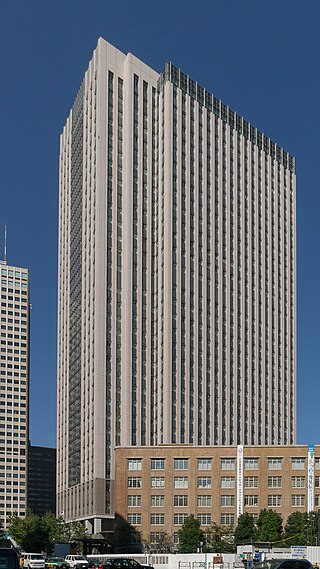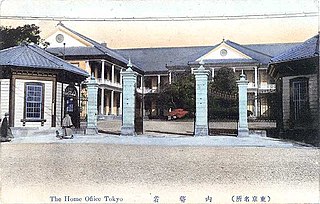| |||||
| Decades: | |||||
|---|---|---|---|---|---|
| See also: | Other events of 1937 History of Taiwan • Timeline • Years | ||||
Events from the year 1937 in Taiwan, Empire of Japan.
| |||||
| Decades: | |||||
|---|---|---|---|---|---|
| See also: | Other events of 1937 History of Taiwan • Timeline • Years | ||||
Events from the year 1937 in Taiwan, Empire of Japan.
Japan conquer Pratas Island.

Japan is an island country in East Asia. It is in the northwest Pacific Ocean and is bordered on the west by the Sea of Japan, extending from the Sea of Okhotsk in the north toward the East China Sea, Philippine Sea, and Taiwan in the south. Japan is a part of the Ring of Fire, and spans an archipelago of 14,125 islands, with the five main islands being Hokkaido, Honshu, Shikoku, Kyushu, and Okinawa. Tokyo is the nation's capital and largest city, followed by Yokohama, Osaka, Nagoya, Sapporo, Fukuoka, Kobe, and Kyoto.

The foreign relations of Japan are handled by the Ministry of Foreign Affairs of Japan.

Hepburn romanization is the main system of romanization for the Japanese language. The system was originally published in 1867 by American Christian missionary and physician James Curtis Hepburn as the standard in the first edition of his Japanese–English dictionary. The system is distinct from other romanization methods in its use of English orthography to phonetically transcribe sounds: for example, the syllable is written as shi and is written as cha, reflecting their spellings in English.

The Japanese Archipelago is a archipelago of 14,125 islands that form the country of Japan. It extends over 3,000 km (1,900 mi) from the Sea of Okhotsk in the northeast to the East China and Philippine seas in the southwest along the Pacific coast of the Eurasian continent, and consists of three island arcs from north to south: the Northeastern Japan Arc, the Southwestern Japan Arc, and the Ryukyu Island Arc. The Daitō Islands, the Izu–Bonin–Mariana Arc, the Kuril Islands, and the Nanpō Islands neighbor the archipelago.

The Ministry of Foreign Affairs is an executive department of the Government of Japan, and is responsible for the country's foreign policy and international relations.

The Ministry of Finance is one of the cabinet-level ministries of the Japanese government. The ministry was named the Ōkura-shō (大蔵省) until 2001. The Ministry is headed by the Minister of Finance, who is a member of the Cabinet and is typically chosen from members of the Diet by the Prime Minister.

The Ministry of the Environment is a Cabinet-level ministry of the government of Japan responsible for global environmental conservation, pollution control, and nature conservation. The ministry was formed in 2001 from the sub-cabinet level Environmental Agency established in 1971. The Minister of the Environment is a member of the Cabinet of Japan and is chosen by the Prime Minister, usually from among members of the Diet.

The Ministry of Education, Culture, Sports, Science and Technology is one of the eleven ministries of Japan that composes part of the executive branch of the government of Japan. Its goal is to improve the development of Japan in relation with the international community. The ministry is responsible for funding research under its jurisdiction, some of which includes: children's health in relation to home environment, delta-sigma modulations utilizing graphs, gender equality in sciences, neutrino detection which contributes to the study of supernovas around the world, and other general research for the future.

The Ministry of Agriculture, Forestry and Fisheries is a cabinet level ministry in the government of Japan responsible for oversight of the agriculture, forestry and fishing industries. Its acronym is MAFF. The current Minister of Agriculture, Forestry and Fisheries is Taku Etō.

The Ministry of Land, Infrastructure, Transport and Tourism, abbreviated MLIT, is a ministry of the Japanese government. It is responsible for one-third of all the laws and orders in Japan, and is the largest Japanese ministry in terms of employees, as well as the second-largest executive agency of the Japanese government after the Ministry of Defense. The ministry oversees four external agencies including the Japan Coast Guard, the Japan Meteorological Agency and the Japan Tourism Agency.

The Ministry of Defense is an executive department of the Government of Japan responsible for preserving the peace and independence of Japan, and maintaining the country’s national security and the Japan Self-Defense Forces.

The Navy Ministry was a cabinet-level ministry in the Empire of Japan charged with the administrative affairs of the Imperial Japanese Navy (IJN). It existed from 1872 to 1945.

The Army Ministry, also known as the Ministry of War, was the cabinet-level ministry in the Empire of Japan charged with the administrative affairs of the Imperial Japanese Army (IJA). It existed from 1872 to 1945.

The JapanSelf-Defense Forces (JSDF), also known as the Japanese Armed Forces, are the unified military forces of Japan. Established in 1954, the JSDF comprises the Japan Ground Self-Defense Force, the Japan Maritime Self-Defense Force, and the Japan Air Self-Defense Force. They are controlled by the Ministry of Defense with the Prime Minister as commander-in-chief.

The Home Ministry was a Cabinet-level ministry established under the Meiji Constitution that managed the internal affairs of Empire of Japan from 1873 to 1947. Its duties included local administration, elections, police, monitoring people, social policy and public works. In 1938, the HM's social policy was detached from itself, then the Ministry of Health and Welfare was established. In 1947, the HM was abolished under the Supreme Commander for the Allied Powers restoration, then its administrative affairs were proceeded to the National Police Agency, the Ministry of Construction, the Ministry of Home Affairs and so on. In 2001, the MOHA was integrated with the Management and Coordination Agency and the Ministry of Posts and Telecommunications, then the Ministry of Public Management, Home affairs, Posts and Telecommunications was established. In 2004, the MPHPT changed its English name into the Ministry of Internal Affairs and Communications. In other words, the MIC is the direct descendant of the HM.

The Japanese Government Railways (JGR) was the national railway system directly operated by the JapaneseMinistry of Railways until 1949. It was a predecessor of Japanese National Railways and the later Japan Railways Group.

Visitors to Japan must obtain a visa from one of the Japanese diplomatic missions, unless they come from one of the visa-exempt countries.

The Government of Japan consists of legislative, executive and judiciary branches and is based on popular sovereignty. The Government runs under the framework established by the Constitution of Japan, adopted in 1947. It is a unitary state, containing forty-seven administrative divisions, with the Emperor as its Head of State. His role is ceremonial and he has no powers related to Government. Instead, it is the Cabinet, comprising the Ministers of State and the Prime Minister, that directs and controls the Government and the civil service. The Cabinet has the executive power and is formed by the Prime Minister, who is the Head of Government. The Prime Minister is nominated by the National Diet and appointed to office by the Emperor.
Japanese New Zealanders are New Zealand citizens of Japanese ancestry, which may include Japanese immigrants and descendants born in New Zealand. Japanese people first began immigrating to New Zealand in the 1890s. Until 1920, 14 Japanese citizens resided in New Zealand. Japanese immigration was halted during the period of the Pacific War and recommenced around the 1950s. From this period onwards, Japanese immigration remained small until the 1990s. In 1997, Japanese peoples were the 19th-largest ethnic group in New Zealand. As of the 2018 census, 18,141 New Zealand residents identify themselves as Japanese New Zealanders.
COVID-19 Contact-Confirming Application, abbreviated as COCOA, is a COVID-19 application for smartphones provided by the Ministry of Health, Labour and Welfare of Japan. The application uses Bluetooth to detect and record suspected close contacts between users. If the contact is diagnosed with COVID-19, the user will be notified. After receiving the notification, the user can consider self-isolation or go to a medical institution for treatment.